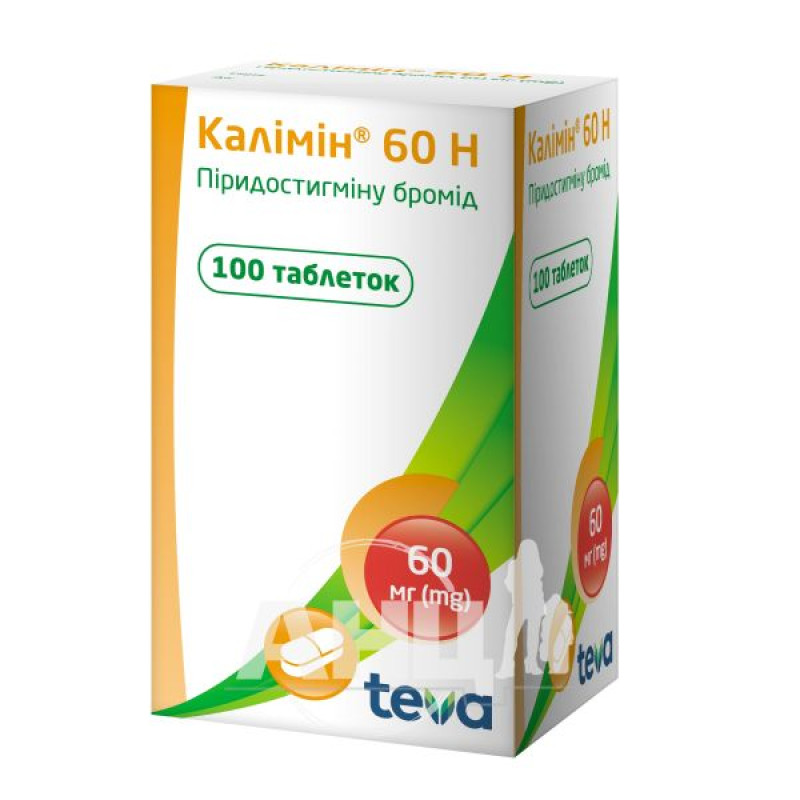Kalimin 60 H tablets 60 mg bottle No. 100

Instructions Kalimin 60 H tablets 60 mg bottle No. 100
Warehouse
active ingredient: pyridostigmine bromide;
1 tablet contains pyridostigmine bromide 60 mg;
Excipients: microcrystalline cellulose, glutamic acid hydrochloride, magnesium stearate, corn starch, povidone, colloidal anhydrous silicon dioxide, precipitated silicon dioxide.
Dosage form
Pills.
Main physicochemical properties: white biconvex oblong tablets with a score line on one side.
Pharmacotherapeutic group
Central nervous system agents. Parasympathomimetics. Pyridostigmine. ATC code N07A A02.
Pharmacological properties
Pharmacodynamics
Pyridostigmine bromide inhibits cholinesterase. It belongs to the parasympathomimetic agents of indirect action. Inhibition of the enzyme promotes the accumulation of acetylcholine on receptors in cholinergic synapses, leading to a more pronounced and long-lasting effect of acetylcholine. The drug mainly acts on the peripheral nervous system. It does not affect the functions of the central nervous system, since due to its low solubility in lipids it does not penetrate the blood-brain barrier.
Pharmacokinetics
Peak plasma concentrations are reached 1.7-3.2 hours after administration of pyridostigmine bromide. Plasma levels of 40-60 ng/ml are achieved after administration of 60 mg of pyridostigmine bromide. In studies in patients with myasthenia gravis, peak blood levels were reached after 3 hours, and clinical and neurophysiological effects were observed after 30 minutes and reached a maximum after 120-150 minutes. There is no clear relationship between dose and plasma concentrations/levels or changes in myasthenic symptoms. However, at levels above 100 ng/ml, the effectiveness of the drug does not increase.
The volume of distribution of pyridostigmine bromide is approximately 0.5-1.7 l/kg body weight.
Pyridostigmine bromide is metabolized in the liver. The main metabolite is 3-hydroxy-N-methylpyridine. Elimination is mainly renal; after intravenous administration the plasma half-life is approximately 1.5 hours. After oral administration the half-life increases to 3-3.5 hours. The oral bioavailability of pyridostigmine bromide ranged from 8% to 20%. In patients with myasthenia gravis, bioavailability may be reduced to below 4%.
Indication
Myasthenia gravis;
myasthenic syndrome (Lambert-Eaton-Rook syndrome) as part of combination therapy with guanidine.
Contraindication
Kalimin® 60 N is contraindicated in patients with a known history of hypersensitivity to the components of the drug, in mechanical obstruction of the gastrointestinal tract and urinary tract; in diseases accompanied by increased tone of the bronchial muscles (for example, bronchial asthma and spastic bronchitis), eye inflammation (iritis), lactation.
Interaction with other medicinal products and other types of interactions
. Combination with other cholinesterase inhibitors or parasympathomimetics may enhance the effect of pyridostigmine bromide. The drug is able to enhance the parasympathomimetic effects of morphine and its derivatives. The effect of depolarizing muscle relaxants (e.g., succinylcholine) is prolonged. Antimuscarinic agents (e.g., atropine) inhibit the muscarinic effect of pyridostigmine bromide on the salivary glands, eyes, heart, bronchial muscles and intestines. Nicotinergic effects on skeletal muscles remain unchanged. Methylcellulose completely inhibits the absorption of pyridostigmine bromide, and activated charcoal almost completely adsorbs it. Aminoglycoside antibiotics (e.g. streptomycin, neomycin, kanamycin, gentamicin), polypeptide antibiotics (polymyxin, colistin), some other antibiotics, e.g. oxytetracycline, clindamycin and lincomycin, a number of antiarrhythmics (quinidine, procainamide, propranolol), penicillamine, lithium, benzodiazepine-type tranquilizers and phenothiazines (e.g. chlorpromazine) may reduce the effect of pyridostigmine and thereby cause myasthenic symptoms. High doses of corticosteroids may also reduce the effect of pyridostigmine bromide.
Application features
Only after careful assessment of the risk and expected beneficial effect should Kalimin® 60 N be prescribed to patients with gastric ulcer, thyrotoxicosis, decompensated heart failure, and myocardial infarction. Kalimin® 60 N should be prescribed with great caution to patients with a reduced heart rate (bradycardia), patients with diabetes mellitus, with kidney disease (if necessary, the dose of the drug should be adjusted), patients with Parkinsonism, with previous liver disease, and after operations on the gastrointestinal tract.
If Kalimin® 60 N was not taken on time, there is no need to increase the dose, but treatment should be continued according to the described dosage regimen. Kalimin® 60 N should not be stopped without prior consultation with a doctor, as the symptoms of the disease may worsen again.
In patients with previous liver diseases, liver function should be monitored regularly.
Use during pregnancy or breastfeeding
There are no sufficient data on the use of Kalimin® 60 N during pregnancy. The use of pyridostigmine bromide in animal studies did not reveal a teratogenic effect when administered orally. However, fetotoxicity and effects on the offspring have not been studied. It is known that intravenous administration of anticholinesterase during pregnancy can cause premature birth. The risk of premature birth is higher when Kalimin® 60 N is administered in the third trimester of pregnancy. Therefore, the drug should be used only after careful assessment of the risk and the expected beneficial effect.
Kalimin® 60 N passes into breast milk, therefore pyridostigmine bromide should not be used during breastfeeding. In cases where the use of Kalimin® 60 N is absolutely necessary, breastfeeding should be discontinued.
The ability to influence the reaction speed when driving or working with other mechanisms
During treatment with the drug, you should avoid driving or operating other mechanisms.
Method of administration and doses
The dose and duration of treatment are determined by the doctor depending on the course of the disease and the patient's response to treatment.
Myasthenia gravis.
For symptomatic treatment of myasthenia gravis in adults, it is recommended to use 1-3 tablets of Kalimin® 60 N 3-4 times a day (180-720 mg per day).
Patients with myasthenia gravis require careful individual dose selection depending on the course of the disease and the patient's response to treatment. The above doses are only recommendations, but the maximum daily dose of 720 mg should not be exceeded.
Myasthenic syndrome (Lambert-Eaton-Rook syndrome).
Treatment should be initiated with Kalimin® 60 N in a daily dose of 180-720 mg, divided into 3 or 4 doses. If this dose is not sufficiently effective, therapy can be supplemented with guanidine in a dose of 375-1000 mg, which should be administered between doses of Kalimin® 60 N.
Treatment of patients with kidney diseases.
Patients with kidney disease should be given the drug in lower doses, since pyridostigmine bromide in unchanged form is excreted from the body mainly by the kidneys (75%). At a plasma creatinine level of 2 mg/dl, half the maintenance dose should be used or the interval between doses should be doubled accordingly. Therefore, the required dose should be selected individually for each patient, depending on the response to drug therapy. Careful medical supervision of such patients is recommended.
The tablets should be taken with a small amount of liquid (approximately 0.5 glass of water).
The tablets have a score line for division.
Children. Kalimin® 60 N should not be used in children.
Overdose
In case of accidental overdose of Kalimin® 60 N, you should immediately seek medical help.
Symptoms of intoxication. Salivation, lacrimation, redness of the skin, increased sweating, fatigue, weakness, constriction of the pupils, visual impairment, dizziness, nausea, vomiting, involuntary urination and defecation, colic and muscle paralysis (as a result of neuromuscular blockade), bronchial spasms, pulmonary edema, decreased blood pressure, bradycardia, possible reflex tachycardia.
Overdose may lead to the development of cholinergic crisis, characterized by pronounced or increasing muscle weakness up to respiratory paralysis, which threatens the patient's life. Other concomitant phenomena may be a decrease in blood pressure to vascular collapse, as well as a decrease in heart rate to complete cardiac arrest or a paradoxical increase in heart rate (reflex tachycardia).
Treatment of overdose. The drug should be discontinued immediately. Gastric lavage and administration of activated charcoal are necessary. In cases of cholinergic crisis, the drug should be discontinued immediately and atropine sulfate should be administered intravenously slowly in an amount of 1-2 mg. Depending on the pulse rate, the administration of atropine sulfate can be repeated after 2-4 hours. It is necessary to maintain a patent airway and, if necessary, provide artificial respiration.
In case of a heart attack, cardiac massage should be performed. Restore water and electrolyte balance. After oral administration of pyridostigmine bromide: gastric lavage and administration of activated charcoal.
Adverse reactions
In individuals with individual intolerance to any component of the drug, hypersensitivity reactions are possible.
From the digestive tract: nausea, vomiting, diarrhea, spastic abdominal pain due to increased intestinal peristalsis, hypersalivation.
Cardiovascular system: decreased blood pressure (hypotension), decreased heart rate (bradycardia), bradyarrhythmia;
On the part of the respiratory system: increased secretion of bronchial glands;
Skin: in rare cases - skin rash;
On the part of the organs of vision: accommodation disorders, increased lacrimation;
Musculoskeletal system: muscle spasms and weakness, muscle tremor;
others: increased sweating, frequent urination.
Cholinergic crisis, among other symptoms, can cause a sudden or gradual increase in myasthenia gravis symptoms up to paralysis. There is a risk of developing respiratory paralysis, which is life-threatening. Other side effects, accompanied by a decrease in blood pressure, can lead to vascular insufficiency, bradycardia and cause cardiac arrest or paradoxical reflex tachycardia. In such a case, after immediate discontinuation of the drug, 1-2 mg of atropine sulfate should be administered by slow intravenous infusion.
Expiration date
3 years. After first opening – 6 months.
Storage conditions
Store at a temperature not exceeding 30 °C out of the reach of children.
Packaging: 50 and 100 tablets in a bottle, 1 bottle in a box.
Release category: By prescription.
Producer
Merkle GmbH.
Location of the manufacturer and its business address
Ludwig-Merkle-Strasse 3, 89143 Blaubeuren, Germany.
There are no reviews for this product.
There are no reviews for this product, be the first to leave your review.
No questions about this product, be the first and ask your question.











